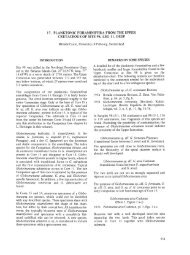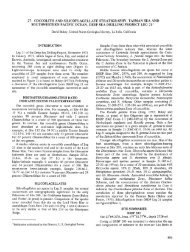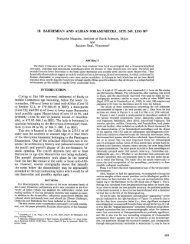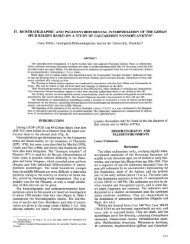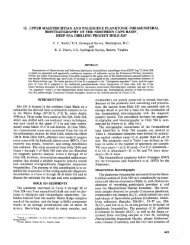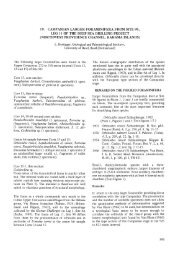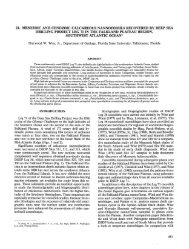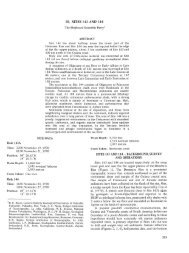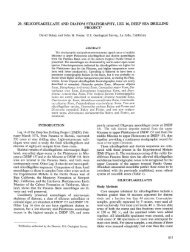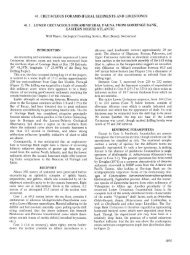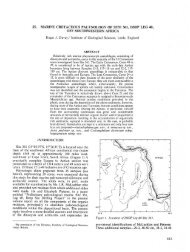16. Radiolaria - Deep Sea Drilling Project
16. Radiolaria - Deep Sea Drilling Project
16. Radiolaria - Deep Sea Drilling Project
You also want an ePaper? Increase the reach of your titles
YUMPU automatically turns print PDFs into web optimized ePapers that Google loves.
M. G. PETRUSHEVSKAYA, G. E. KOZLOVA<br />
ε s<br />
Zone<br />
li<br />
U<br />
.^<br />
•3 S<br />
ε js<br />
ε<br />
.3 cd<br />
"3S<br />
so<br />
•«?<br />
13 § •§ It<br />
à X •S• ×<br />
CΛ SI O<br />
S δ<br />
II<br />
II<br />
radiolarian assemblage in a sample. For the characterization<br />
of the total assemblage, the same letters "a", "c", "f" and<br />
"r" are applied. The preservation of the skeletons is<br />
506<br />
classified as "good - g" (all specimens are preserved),<br />
"moderate - m" (some specimens are destroyed, in fragments,<br />
nassellarians without heads) and "poor - p" (nearly<br />
all specimens are destroyed or dissolved).<br />
Site 138 (25° 55.37'N, 25° 33.70'W; water depth 5288<br />
meters)<br />
Rare radiolarians occur at about 52 to 61 meters<br />
below the sea floor (1-CC); they apparently belong in<br />
the Calocycletta veneris Zone. Frequent radiolarians of<br />
moderate preservation occur from 110 to 113 meters<br />
below the sea floor (Core 2). <strong>Radiolaria</strong>ns from the<br />
upper part of this core seem to belong in the upper<br />
part of the Calocycletta tuberosa Zone. The lower<br />
part of Core 2 seems to belong in the lower part<br />
of the Calocycletta tuberosa Zone. Paleocene?<br />
radiolarians from Core 4 were not studied. Lower<br />
than 332 meters below the sea floor, Cretaceous<br />
radiolarians of poor preservation occur (see "Cretaceous<br />
Occurrences").<br />
Site 139 (23° 31.14'N, 18° 42.26'W; water depth 3047<br />
meters)<br />
<strong>Radiolaria</strong>ns, if present, were of good preservation, and<br />
the assemblages are rich in species and in individuals.<br />
<strong>Radiolaria</strong>ns are common and even abundant from 114<br />
to 123 meters below the sea floor (Core 1). These samples<br />
seem to belong no lower than the Pterocanium prismatium<br />
Zone.<br />
<strong>Radiolaria</strong>ns are frequent and even common from 345 to<br />
576 meters below the sea floor (Core 3). Sample 3-CC<br />
contains a Middle Miocene assemblage. It is difficult to<br />
determine the zone it belongs in, but it may be in the<br />
lowest Cannartus petterssoni Zone. Samples 4-CC, 5-CC and<br />
139-SW1 seem to belong in the Calocycletta costata Zone.<br />
Core 7 (576 to 665 meters below the sea floor) is poor in<br />
radiolarians; it apparently belongs in the Calocycletta<br />
veneris Zone. Sample 7-CC is abundant in radiolarians; it<br />
belongs in the lowest part of the Calocycletta veneris Zone.<br />
Site 140 (21 C<br />
meters)<br />
44.97'N, 21° 47.52'W; water depth 4483<br />
Hole 140<br />
Well-preserved radiolarians are common from about 201<br />
meters below the sea floor (Core 2). The samples from the<br />
upper part of this core seem to belong in the lower part of<br />
the Dorcadospyris alata Zone. The middle part of this core<br />
(Section 2 and 4) appear to belong in the Calocycletta<br />
costata Zone. The lower part of Core 2 and Sample 2-CC<br />
apparently belong in the Calocycletta veneris Zone, but the<br />
slide marked as 2-CC contains an abundance of wellpreserved<br />
Late Eocene radiolarians. It apparently belongs in<br />
the upper part of the Thyrsocyrtis bromia Zone.<br />
Well-preserved (but many fragmented) radiolarians are<br />
common in Core 3 (311 to 318 meters below the sea floor).<br />
These samples seem to belong in the Lampterium goetheana<br />
Zone.<br />
Poorly preserved skeletons (infilled with silt) are<br />
abundant in Core 4 (368 to 374 meters below the sea<br />
floor). Apparently it belongs in the Low Eocene (similar to<br />
the samples described by C. Nigrini, 1970).



